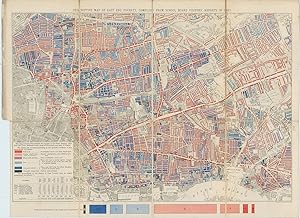About this Item
Original lithographed map, printed in colours, of East London (37 x 49 cm overall), dissected into 8 sections and mounted onto linen as issued, folding to 21 x 13 cm. Faint toning and occasional faint spotting to linen along folds, generally a very good example. The first of Charles Booth's famous poverty maps of London to be published, in his seminal work ?'Labour and Life of the People, Volume 1: East London'. The areas it covers include Hoxton, Bethnal Green, Whitechapel, Mile End Road and Limehouse. When the full survey was published in 1891 this map was dropped for one matching the other three in the set. However this early map has the same features, with the streets colour-coded according to the degree of wealth of the inhabitants, ranging from black ('Very poor, lowest class… Vicious, semi-criminal'), through shades of blue and purple ('Poor', ?'Mixed', ?'Fairly Comfortable'), to red ('Well to do'). Booth's highest class, yellow ('Wealthy'), does not appear on this map. Charles Booth (1840-1916), owner of the Booth Shipping Line, had always taken an interest in the welfare of working men; but it was not until he was past middle age that there began to appear the works which established his reputation as a writer on social questions, including his enquiry into the condition and occupations of the people of London, the earlier part of which appeared (along with this map), as Labour and Life of the People (1889), and the whole as Life and Labour of the People in London (1891-1903). Booth's works appeared at a critical time in the history of English social reform when a lively interest was being taken in the problems of pauperism, and it was coming to be recognised that benevolence, to be effective, must be scientific. As such Life and Labour was designed to show "the numerical relation which poverty, misery, and depravity bear to regular earnings and comparative comfort, and to describe general conditions under which each class lives". Among the many volunteers who helped him to compile his material were his wife's cousin Beatrix Potter and (Sir) Graham Balfour (for the earlier volumes), and Ernest Aves (for the later). Booth's object was to give an accurate picture of the condition of London as it was in the last decade of the nineteenth century; in this light, his Life and Labour was recognised as perhaps the most comprehensive and illuminating work of descriptive statistics which had yet appeared. 'Quite the most important thematic maps of the Metropolis in the nineteenth century were those which accompanied Charles Booth's Monumental survey' (Hyde p. 28). Hyde 252. Seller Inventory # 58691
Contact seller
Report this item
![]()
